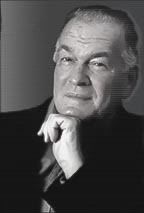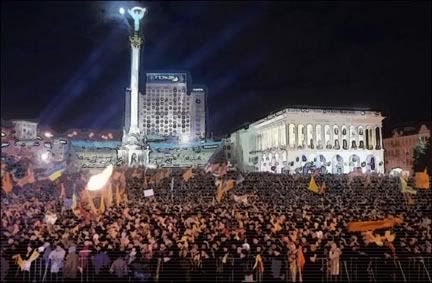His particular focus at Ohio State had been on Gandhi’s non-violent movement in India, a scope that widened after Sharp moved to England to earn a doctorate in political theory from the esteemed Oxford University in 1968. By then he had already begun taking research appointments at Harvard’s Center for International Affairs, where he took a faculty position after Oxford, over the next three decades earning a reputation as Harvard’s “Clausewitz of nonviolent warfare.” [1]
At the heart of Sharp’s intellectual career is the organization of a system whereby civil resistance could be used, when negotiation and persuasion has finally been ruled out, to peacefully overthrow a government. At its brilliant core is the realization that in order to remain in power, a leader needs the support of people who remain loyal; a government’s power is to a large extent centered in the heads of its citizens (not to mention its politicians, business leaders, military personnel, etc.) Thus if those people can be brought to break the shackles of mental slavery and recognize that they are the source of the state's power, they can refuse their obedience and their leaders will be left helpless and vulnerable.
Sharp’s later catalog of writings is impressive: The Politics of Nonviolent Action (1973) is widely considered the definitive study of nonviolent struggle. Making Europe Unconquerable (1985) focused on a civilian-based defense for Western Europe, a theme further developed in the provocatively titled Civilian-Based Defense: A Post-Military Weapons System (1990). In these books he argued that organized nonviolent defiance could deter or turn back even well armed occupiers or depose internal tyrants. The latter book was reportedly put to use in the early 1990s by the newly independent governments of Estonia, Latvia, and Lithuania “in planning their defense against Soviet efforts to regain control.” [2]
 |
To further solidify his mission, Sharp founded the Albert Einstein Institution (AEI) in 1983, dedicated to “advancing the study and use of strategic nonviolent action in conflicts throughout the world.” [4] Einstein was chosen as the namesake because, as the AEI website explains, “at various times he was a war resister, a supporter of the war against the Nazi system, and an advocate of world government” and later saw “the potential of nonviolent struggle.” [5] Einstein was impressed enough that he provided a foreword for Sharp’s first book in 1960. [6] The book was called Gandhi Wields the Weapon of Moral Power, yet Sharp rejected the spiritual core of that moral power. In a 2005 interview he explained his research into Gandhi’s struggle was based “not [on] pacifism, not on any mahatma nonsense, but on pragmatic nonviolent struggle.” [7]
Sharp watched with approval the wave of revolutions across the former Soviet empire and its client states 1n 1989-91, and in 1993 he released an early version of his most widely-read book, From Dictatorship to Democracy: A Conceptual Framework for Liberation (abbreviated FDTD). The book was first published not in English, but in the four major Burmese dialects, printed by installment in newspapers in Thailand, and smuggled into neighboring Burma (Myanmar), where a long-running struggle of citizens against a repressive regime was underway. [8] The book was also put to use in existing US-sponsored tactical training of Burmese opposition forces, a case we’ll look at below.
So far the book’s suggestions have not been carried through to regime change there, but besides the four initial-run languages, FDTD has since been translated into more than twenty different languages, including Arabic, Belarusian, Chinese (traditional and simplified), Indonesian, Russian, Serbian, Spanish and Ukrainian and spread worldwide on well-funded winds. Through the 1990s and with strong support from a growing network of powerful individuals and organizations, the book served widely as a handbook for all the peoples of Eastern Europe, Central or East Asia and Latin America emerging from Communist oppression or hoping to emerge from any other oppression that was disfavored in Washington.
As Sharp notes, once a dictator’s “sources of power” have been located and the public mobilized, “then the population will be able, when needed, to restrict or sever the supply of those sources.” [9] He does not specify who would decide just when such a severing would be needed, but others have had plenty of good ideas. And once a dictator is deposed, even nonviolently, the question remains of who would then take the reins of power, which after all abhors a vacuum. When one leader replaces another, it’s sometimes called a “coup d’etat,” often an anti-democratic procedure with which the US government prefers not to be associated (not that that always stops them). Whatever his original intentions in this endeavor, Sharp wound up designing a template for what journalist Jonathan Mowat would later come to call “the postmodern coup d'etat,” one that sneaks in under cover of a people’s movement. [10]
A final irony - Sharp's initial talk of a "post-military weapons system" seems well-intentioned enough, a reflection of a hope that the we were moving towards a post-military world. But by the year 2000 his nonviolent template was set to remove a foreign head of state in Serbia, the heart of a disintegrating Yugoslavia which had just whethered two separate NATO bombing campaigns and tightening UN sanctions. Since Sharp's notions were finally used there to finish what the bombs had begun, the "post-military" descriptor takes on a less phiolosophical, more tactical quality. It's not about warfare in a weaponless world, it's about the warfare the commences post-militarily - when the actual bombing is done.
Next: Weaponizing Nonviolence: Col Helvey
Sources:
[1], [2], [6] "Gene Sharp: A Biographical Profile." Peace Magazine. http://www.peace.ca/genesharp.htm
[3] Transcript: An Interview with Gene Sharp. Conducted by Metta Spencer, Peace Magazine. July 9, 2003. http://www.why-war.com/news/2003/07/09/aninterv1.html
[4] Albert Einstein Institution – website – mission
[5] Albert Einstein Institution. “About our Name.” Accessed May 12 2006 at: http://www.aeinstein.org/organizationsf7bd.html
[7] Secor,Laura. "War by other means: Boston's Gene Sharp learned how to turn nonviolence into a weapon - and helped quite literally change the world." Boston Globe. May 29 2005. http://www.boston.com/news/globe/ideas/articles/2005/05/29/war_by_other_means/
[8] Rozen, Laura. "Dictator downturn: It just isn't as easy being a tyrant as it used to be." Salon. February 3 2001. http://archive.salon.com/news/feature/2001/02/03/dictators/print.html
[9] Book Review: "Waging Nonviolent Struggle:20th Century Practice and 21st Century Potential." Gene Sharp, Porter Sargent Publishers, 2005, Boston, 598 pages. John Bacher (reviewer)http://www.peacemagazine.org/archive/v21n3p28.htm
[10] Mowat, Jonathan. “Coup d'État in Disguise: Washington's New World Order "Democratization" Template” Center for research on Globalization. February 9, 2005. http://www.globalresearch.ca/articles/MOW502A.html


2 comments:
"Guerrillas" is indeed a good description. Just as guerrilla's they provoke the government in the hope that it will overreact what they then will use against it to delegitimize it. It is for a considerable extent a propaganda tactic and lies abound.
But as with every trick there is a counter-trick. After Ukraine Belarus and Russia knew how to prevent that they would be next. And when the Iran's Green revolution was at its zenith there were Belorussian leaders in Tehran - very likely to advise them. The trick is something like to be early and subtle yet resolute.
http://nation-building.blogspot.com/2008/05/how-otpor-beat-milosevic.html
On a fluke, I checked the pending comments and approved this six months late. Clearly, this site is not actively managed. There was way too much to cover as this whole concept came back to moreliteral guerillas, "protesters" WITH guns in Libya, Syria, etc.
I like your insights, Wim. Is that your site? I've seen it around, had a good impression. Keep it up!
Post a Comment